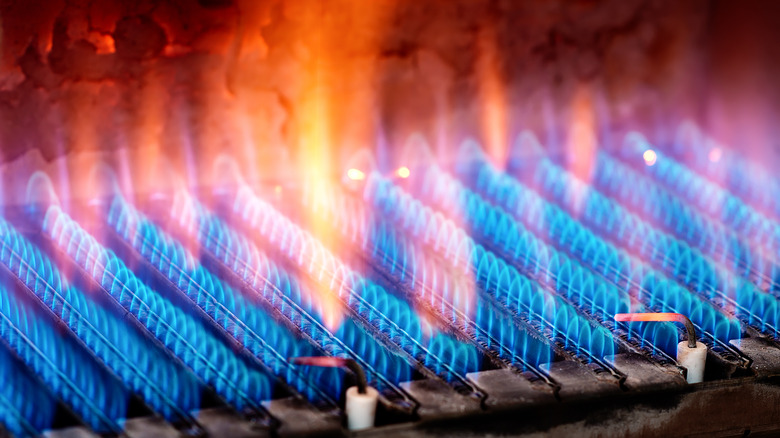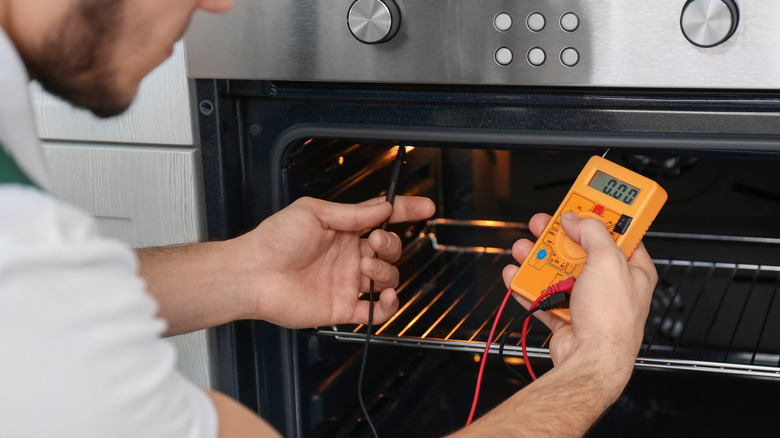Why Your Gas Oven Takes So Long To Preheat
Forgetting to preheat the oven is one of the telltale signs of a rookie in the kitchen. Putting raw ingredients into a cold oven extends the cooking time by about the same amount of time as it takes to preheat the oven in the first place. According to Food52, that longer, colder cook leads to dry cookies, tough cake crumbs, and overcooked meats. Although it might seem wasteful to run the oven while it's empty, overall it saves energy to do it this way, and it's better for the food.
Per Consumer Reports, gas is still the best option for oven baking, with more than 70% of ovens reviewed getting an Excellent or Very Good rating. Gas ovens can take 15 to 20 minutes to preheat though, notes GE Appliances. If you're finding that it's taking longer than 20 minutes to reach the target temperature, then there could be some issues with your oven. Fixing them might save a lot of energy and some dollars from your gas bill as well.
Read on to find out the most common reasons a gas oven isn't preheating properly, as well as a tip to cut down preheating time, no matter what state your oven is in.
Reasons why gas ovens don't preheat correctly
There are several reasons why a gas oven might not be heating properly, ranging from a simple DIY fix to a repair requiring a professional. The first thing to check is your oven door. A bad seal will cause leakage and your oven will never quite reach the necessary cooking temperature. If this is the issue, fixing the hinges and upgrading your door seal could be enough to solve the issue.
Another simple reason for slow preheating times, according to ABC Home and Commercial Services, is a faulty thermostat. Make sure it isn't touching the inside wall of the oven, for example. If the issue is the temperature sensor, that's a relatively easy fix, and moving or replacing it should return your oven to normal operation.
The most common problem, however, is a broken igniter. These are only designed to last four or five years, and when they fail, the oven is unable to get hot enough. Repair Clinic explains that to check the igniter you must observe it to see if it begins to glow or not. If it begins to glow, but the burner does not ignite, it's time to install a new one.
Beyond these simple and common problems, things will get more troublesome to address. Replacing the internal elements of an oven, such as the control board or safety valve, is probably best left to a professional, says American Home Shield.
How to live with an oven that slowly preheats
According to How to Fix It, the igniter is easy enough to replace. Once you get to the point of needing professional assistance, it's worthwhile exploring whether the preheating issue is something you can work around without incurring repair expenses. For example, if the issue was specifically generating heat quickly, Kitchen Snitches advocates turning your broiler on high for 3 to 5 minutes to blast the interior with heat. Then revert to proper settings for smoother temperature control. This is something anyone can do to speed up preheating time when necessary. So, if your oven works well this way, do you need to replace it?
Kitchen tools with quirks are the kind of thing that many home cooks learn to deal with. Ovens have always had hot spots, which bakers just know to work around. Depending on how bad your oven's issues are, that might be a possible solution in your case too.
Fans of baked goods might want to do a batch test. Using racks full of a consistent product like sliced white bread or pre-made cookie dough, fill the oven completely, and cook until done. Per CNET, this will give you a grid that shows how evenly (or not) the oven is performing, helping you pinpoint the problem. Once you've identified the issue, you can decide how best to proceed.


